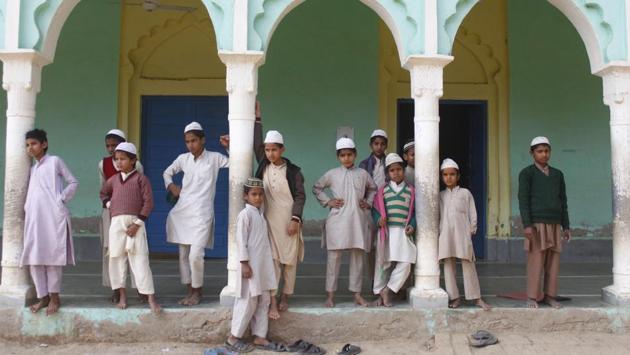What ails madarsas and their desire to go modern?
Nothing working: Inadequate number of teachers, pathetic infrastructure, missing salaries making it difficult to teach ‘modern’ subjects.
Nabi Jaan teaches modern as well as religious subjects at Madarsa Jamia Farooqia in Varanasi. He like many of his ilk were upbeat about the government’s new-find emphasis on madarsa modernization, which meant introduction of modern subjects like mathematics, English, social science and computer into their syllabus.

But as time passes, he is losing hope. “The emphasis looks hollow today because the madarsas haven’t been provided sufficient teachers by the state government’s Madarsa Board to teach modern subjects. Paucity of qualified teachers and infrastructure are some of many problems on way to modernization of madarsas,” says Nabi Jaan.
“The Uttar Pradesh government’s Madarsa board introduced a new syllabus, including modern subjects like mathematics, science, English and computer in all the Madarasas in 2011. But they didn’t provide sufficient teachers. They only provided three teachers each for the madarsas,” he says.
Like many madarsas, Jaamia Farooqia runs Munshi Maulvi, Alim, Kamil and Fazil courses which are equivalent to high school, intermediate, BA and MA respectively.
“In my madarsa, we have only two teachers for modern subjects. They teach English, mathematics and social science to the students pursuing Munshi Maulavi, Alim courses,” he says adding, there are no teachers for available at the graduation level.
UP general secretary of teachers association Madaris Arabia Haji Diwan Sahab Zama, principal at Madarsa Madinatul Uloom, Jalalipura, refers to similar problems. “Around 1,200 students are enrolled in different courses at our madarsa. There are only three teachers to teach modern subjects. Is it possible for three teachers to impart education to 1200 students,” Haji Zama says.
Take basic computer education for instance, the board hasn’t provided any computer teacher, he says.
Hazi Jama says there are two types of teachers in madarsas. Regular teachers, who are appointed by the respective committee of each madarsa under supervision of Madarsa Board. Then there are contractual teachers for teaching modern subjects. These teachers are hired by the respective management committee of each madarsa after due approval of the board. But the difference is that the regular teachers, who usually teach religious subjects at madarsas, get salary from the state government, while those on contract get a monthly honorarium provided jointly by the state government and the centre, Jama says.
Graduate teachers are given ₹8,000 monthly which includes ₹6000 by the centre and ₹2000 by state government. Trained teachers with a graduation degree are given a monthly honorarium of ₹15,000 -- ₹12,000 by centre and ₹3000 by the state government.
Jama says while the state government provides its share of the honorarium to the teachers from time to time, teachers haven’t received the honorarium from the centre for the last 35 months. “This is another big problem. These teachers are facing difficulties due to ‘indefinite delay’ in providing honorarium,” Jama says adding, no trained teachers are now willing to join.
He says the new syllabus was introduced by the UP Madarsa Board in 2011 and was fully implemented in 2012. The board made maths and English compulsory in Munshi Maulvi (high school). Computer was also introduced as an optional subject in Munshi Maulavi and Alim. In Kamil, the board introduced social sciences such as history and geography.
“Computer is the need of the hour. Therefore, this was a good move. But the board or state government must provide teachers,” Zama says.
As part of modernization in May 2018, the state government led chief minister Yogi Adityanath introduced National Council of Educational Research and Training (NCERT) textbooks of science, mathematics and social science in madarsas, Jama says wondering how will the madarsas give it a go if they face so many problems.
Madarsas have been demanding that like Sanskrit Schools that are affiliated to Sampurnand Sanskrit University, madarsas should be affiliated to a university like Rampur’s Maulana Mohammad Ali Jauhar University or any other varsity so that those who are doing Kamil and Fazil may apply for government jobs after completion of their courses, says Zama while lamenting their demands have so far had no takers.
He explains the problem further. After doing courses like Kamil and Fazil, the youths apply for the government jobs but their application is rejected as Kamil and Fazil are not recognized degrees. “If madarsas get affiliation, they would be able to give degrees which are recognized and valid.”
Jama says BJP’s prime ministerial candidate Narendra Modi had in May 2014 said, “Education will be my priority. I will encourage Muslims to hold the Koran in one hand and a laptop in the other.”
He says Modi repeated his observation again in March 2018 and he had welcomed the statement, hoping that there would be change in the situation, but nothing happened.
In January 2018, UP chief minister Yogi Adityanath too said. “We can think about modernisation of madrasas. Closing them down is not a solution but timely improvements should be considered. I also ask Sanskrit schools that besides imparting traditional education they should provide computer, English, science and mathematics education to face competition.”
District minority welfare officer Ramesh Chand says facilities are being provided to madarsas under their modernization programme as per guidelines.
He says the madarsa teachers apprised him of the issues recently which he has sent to the state government.
A senior official of the department of minority welfare says that an amount of ₹100 crore for modernization of madarsas was provided to the Department of School Education, Government of India in 2014-15 by the government under Infrastructure Development Minority institution (IMDI) scheme. The amount was given accordingly to the states’ minority welfare departments which gave it to the madarsas.






